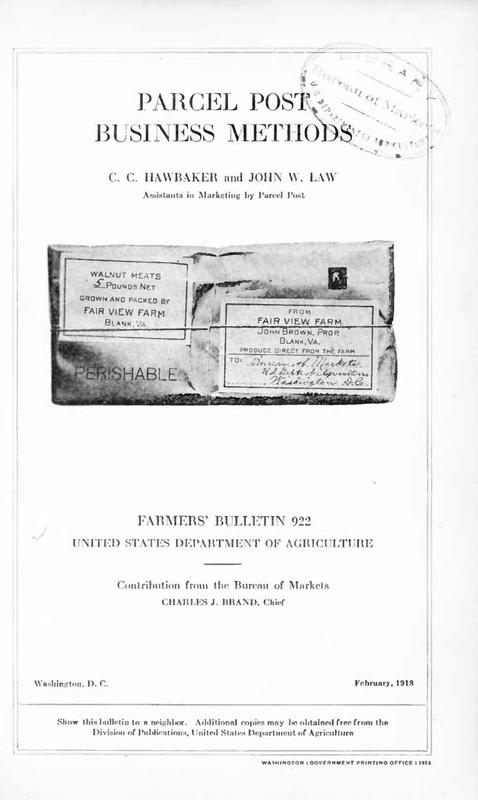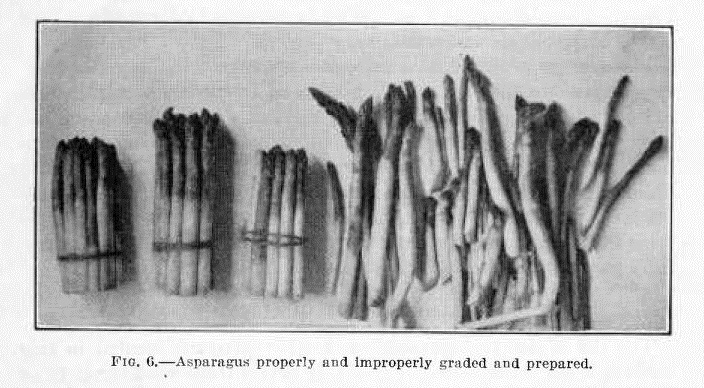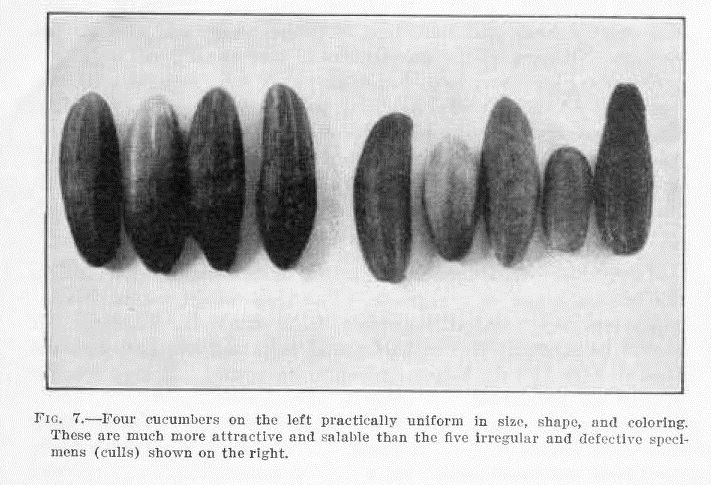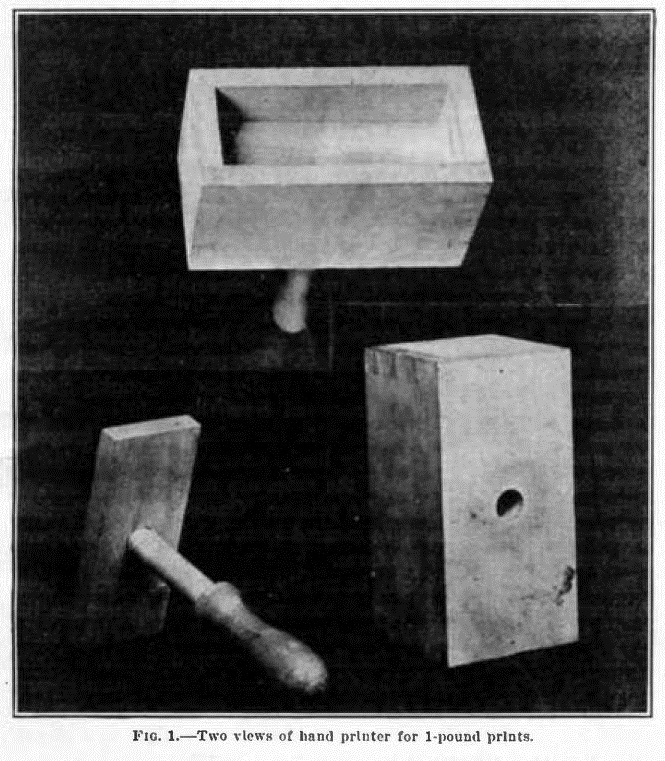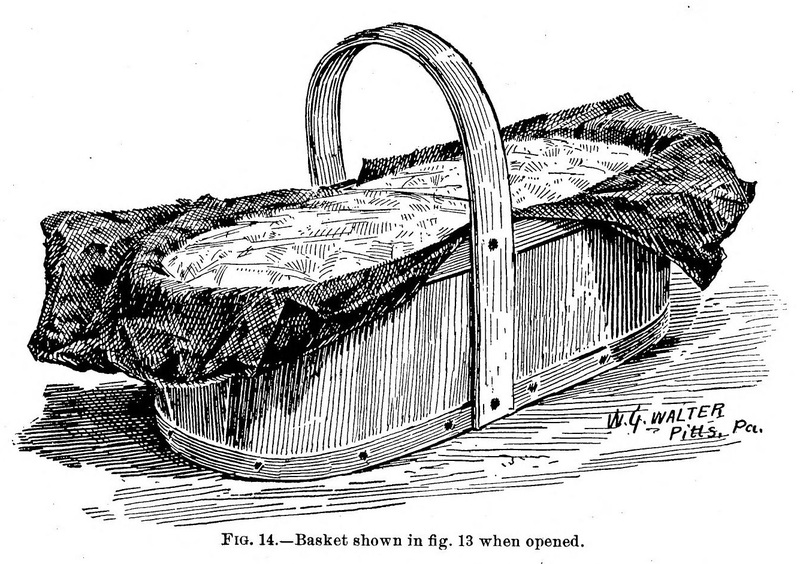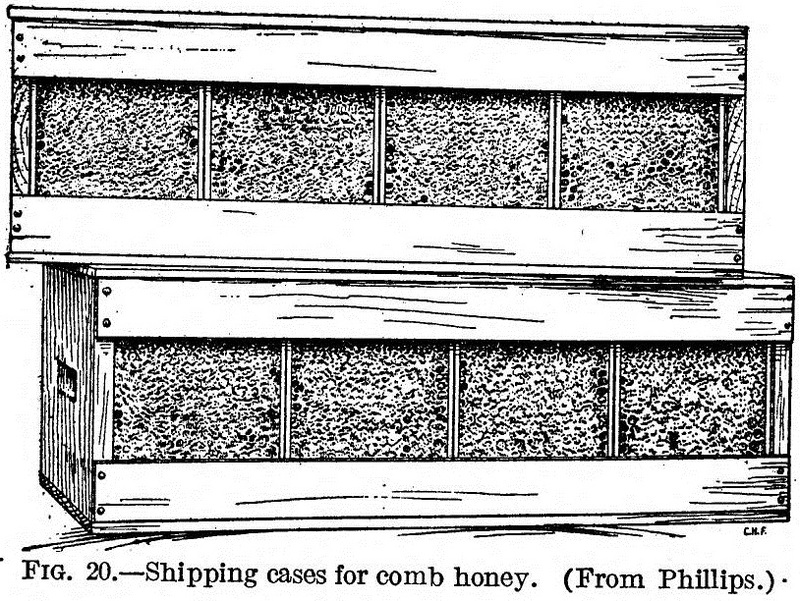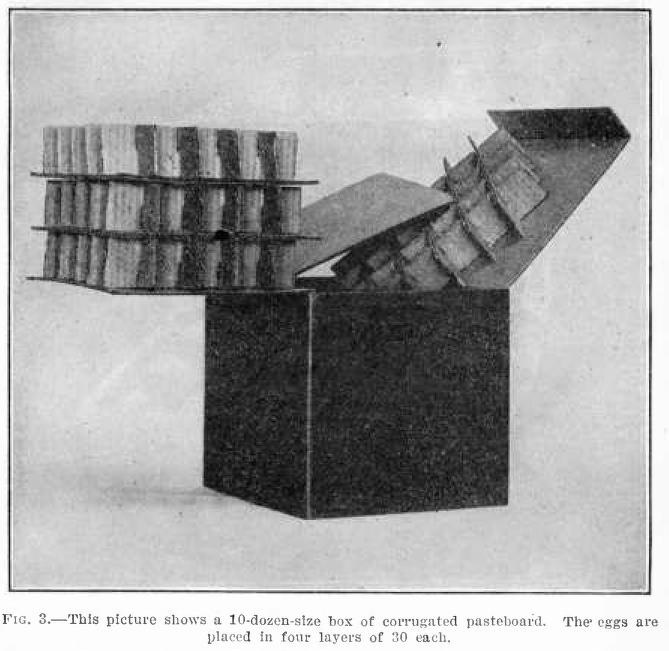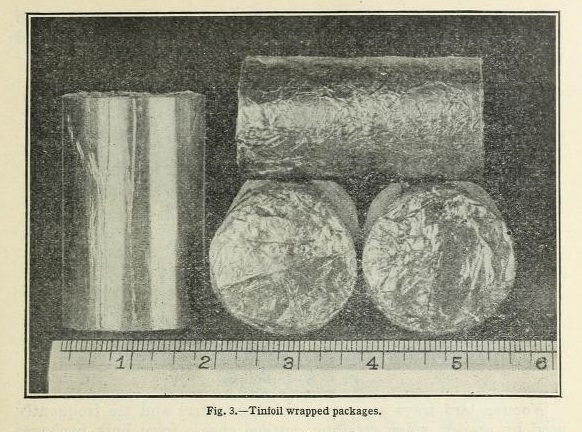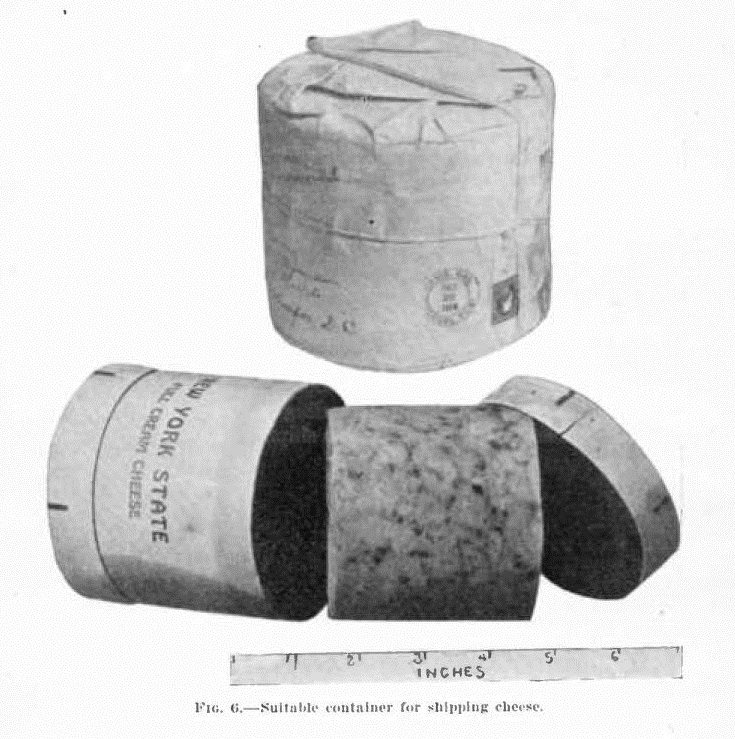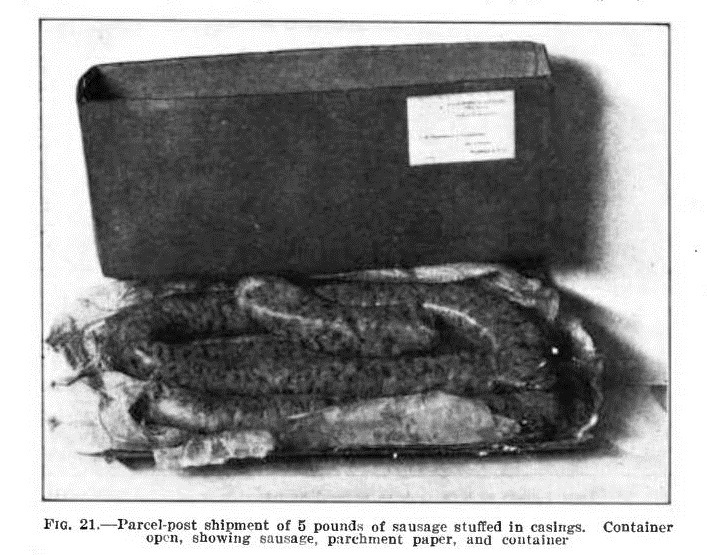USDA Support to Farmers for Parcel Post Marketing
The U.S. Department of Agriculture offered support to farmers as they entered this new type of direct-to-consumer marketing arrangement. Several issues proved difficult to master:
-
Connecting Producers With Consumers
Shipping Eggs by Parcel Post. Hawbaker, Flohr, Lewis L. (1914). U.S. Department of Agriculture. Farmers' Bulletin, Number 594
"METHODS OF BRINGING PRODUCER AND CONSUMER TOGETHER
One of the big problems to the average farmer is how to secure customers who desire eggs direct from the farm. In other words, the question is, 'How shall I come in, contact with the person who wants my product?'
An occasional contact may be secured through acquaintance in the city or town where a parcel-post market is sought. Contact might also be secured by a small advertisement in a city or town paper, stating the number of eggs available per week. In France city dwellers make these business arrangements in summer when in the country on their holiday. Consumers who will not take trouble about these relatively small things should not complain of the high cost of food products.
Additional contact ought to be more easily obtained than the original contact, for the simple reason that if a producer supplies satisfactory eggs the person receiving them is almost sure to obtain other customers for him by speaking well of his product. It might be said in this connection that the reputation a parcel-post shipper makes with his first customers will very largely determine his success or failure in marketing by this method.
The matter of holding business once secured and securing additional business is of considerable importance. One of the serious drawbacks of ordinary farming is the great irregularity of income during the year. The development of a regular parcel-post business in eggs and the many other products that may be marketed by this means will increase the income and distribute it somewhat better throughout the year. Once a customer has been secured every endeavor should be made to furnish strictly high-grade goods and to deal fairly, promptly, and satisfactorily, so that the customer may be retained. Once a reputation is established for products of high quality and for fair dealing, the holding of customers and securing new ones will be a comparatively simple matter." pp. 12-13
Parcel Post Business Methods. Hawbaker, C. C. and Law, John W. (1918). U.S. Department of Agriculture. Farmers' Bulletin, Number 922
"The postmasters in 41 cities, under the direction of the Post Office Department, have instituted campaigns intended to foster parcel-post marketing. The names and addresses of producers, together with the kinds of produce offered, are listed free for distribution to the patrons of the offices; and some of these postmasters issue for distribution to producers lists of names of consumers who wish to buy. Many producers and consumers have established business relations by this method. For various reasons some have found their dealings unsuccessful. Much depends on promptness and on businesslike methods in answering correspondence.
A producer who wishes to have his name listed should write to the postmaster of the city selected, giving his name, address, the produce offered for sale, and prices. Persons in any of these cities can obtain a copy of the list on application to the postmaster either by letter or in person.
The cities in which campaigns have been instituted are as follows:
Athens, Ga. Atlanta, Ga. Austin, Tex. Baltimore, Md. Birmingham, Ala. Boston, Mass. Brooklyn, N. Y. Chicago, Ill. Cincinnati, Ohio. Cleveland, Ohio. Dallas, Tex. Denver, Colo. Detroit, Mich. Galveston, Tex. Greenville, S. C. Hartford, Conn. Indianapolis, Ind. Jacksonville, Ma. Kansas City, Mo. La Crosse, Wis. Lawrence, Mass. Lincoln, Nebr. Los Angeles, Cal. Louisville, Ky. Lynn, Mass. Memphis, Tenn. Minneapolis, Minn. Nashville, Tenn. New Orleans, La. Philadelphia, Pa. Pittsburgh, Pa. Portland, Oreg. Providence, R. I. Raleigh, N. C. Richmond, Va. Rock Island, Ill San Francisco, Cal. Seattle, Wash. St. Paul, Minn. St. Louis, Mo. Washington, D. C." pp. 7-8
-
Selecting the Best Products for Shipment
Suggestions for Parcel Post Marketing. Flohr, Lewis B. and More, C. T. (1916). U.S. Department of Agriculture. Farmers' Bulletin, Number 703.
"Producers should at all times strive for uniformity in the products shipped — uniformity of size especially, and also of color and quality. Figure 6 shows three bunches of asparagus of uniform size and quality, neatly tied; also a quantity of loose asparagus, quite variable in size and quality, which would not sell well. The same general principles which applied in the selection and grading of the bunched asparagus should apply to the preparation and grading of all other produce.
It may be stated that as a usual proposition it is feasible to ship only the produce that is of high value in comparison with its weight. In any case, the net returns will be the determining factor; only general facts can be stated in this connection. In family baskets or containers, or in assorted lots of vegetables and of fruits, there is likely to be a demand for the inclusion of many of the heavier articles, such as potatoes, cantaloupes, cabbage, and onions, the shipment of which alone might not be justified." pp. 11-12
"Fig. 7. — Four cucumbers on the left practically uniform in size, shape, and coloring. These are much more attractive and salable than the five irregular and defective specimens (culls) shown on the right.
Cucumbers — For slicing, only the long, straight, smooth, green cucumbers from 6 to 9 inches in length should be shipped. The spongy, thick, yellow, runty, or overlarge ones, or those having wilted or shrunken ends, should be culled out. The cucumbers should be cut and not pulled from the vine.
For pickling, cucumbers should be of the size desired by the customer, such as "midgets," the very small ones, 2-inch, 3-inch, dill-pickle size, etc." p. 16
-
Preparing Products for Shipping
Marketing Butter and Cheese by Parcel Post. Flohr, Lewis B. and Potts, Roy C. (1918). U.S. Department of Agriculture. Farmers' Bulletin, Number 930
"PREPARATION OF BUTTER FOR PARCEL-POST SHIPPING
The methods used in preparing butter for parcel-post shipping depend largely upon the local conditions and the style of package used. To insure delivery in the best possible condition, butter, after being packed or printed and placed in cartons, should be chilled or hardened thoroughly before it is shipped.
One of the most satisfactory ways of preparing butter for shipment is in the form of regular 1-pound prints. The standard print measures 2 1/2 by 2 1/2 by 4 5/8 inches. A hand butter printer or mold should be used in forming the prints. The printer shown in figure 1 is so made that it can be taken apart readily and thoroughly cleaned. The print of butter is easily removed from the mold by the false bottom. Another style is made with the sides and ends hinged: to the bottom and held in place by hooks across the ends. After the butter is packed in the mold the sides are unhooked, so that the butter can be removed from the printer. One-pound hand printers similar to these styles may be secured from dairy-supply companies or they may be made on the farm.
Each pound print should be neatly wrapped in regular butter parchment or paper. A second thickness of such paper has been found to add materially to the carrying possibility of the butter. Waxed paper may be used for the second wrapping. As a further protection to the print, it should be placed in heavy manila paraffined cartons, which may be obtained from folding paper-box companies for about one-half cent each when unprinted or at a slightly additional cost when printed as a stock carton or with a special private brand." p. 5
-
Packing Items Properly
How to Grow Mushrooms. (1897). Falconer, William. U.S. Department of Agriculture. Farmers' Bulletin Number 53
[This publication gives advice to the mushroom grower before the advent of the parcel post, "Farm-to-Table" initiative. Note the prices and delivery routes quoted]
"[This basket] was a most tasteful example of packing mushrooms for market or distant shipment. The basket was of common, cheap chip. It was lined with blue tissue paper, and the mushrooms, every one of which was fresh, plump, and solid, and gathered just before the veil broke, were packed most carefully and as solidly as apples in a barrel, but were not crushed. Around the sides and over the top of the basket a sheet of waxed paper was laid, the outer wrapper being manila paper. The express charges on it were 70 cents — 15 cents from Long Island to New York, 40 cents from New York to Pittsburg, and 15 cents for delivering." p. 16
Comb Honey. Demuth, George S. (1912). U.S. Department of Agriculture. Farmers' Bulletin, Number 503
"Comb honey is usually packed in cases holding 24 sections (fig. 20). Other sizes are sometimes used to meet special market requirements. The markets have become accustomed to cases with glass fronts, by means of which the contents are displayed to advantage. However, in keeping with present practice in other package goods, considerable comb honey is now placed on the market having each section inclosed in a carton. This practice, while losing the advantage of displaying the honey, has a decided advantage in insuring security from dust and insects while in the markets as well as greater safety to the fragile comb when the package is finally delivered to the consumer.
Many beekeepers are able to dispose of their entire output of honey in their local markets, sometimes creating quite a demand for their product by advertising and demonstrating. Comb honey that is to be sent to a distant market should be shipped before cold weather, since the combs become extremely fragile when cold. Small lots should be crated in "carriers" holding several cases to prevent breakage by rough handling of individual cases, while in larger shipments the cases are simply packed in the car in such a manner that the individual cases can not be thrown about by the movement of the car." pp. 46- 47
The Community Egg Circle. Bassett, C. E. and Kerr, W. H. (1915). U.S. Department of Agriculture. Farmers' Bulletin, Number 656
"When it is estimated that the annual production of poultry and eggs in the United States is in excess of $600,000,000 — equal to the value of the hay or the wheat crop — and when it is estimated that there is a total loss of nearly 8 per cent of the eggs marketed, the importance of this subject is evident. This great loss is due largely to improper handling between the farm and the market. Most farmers look upon eggs as a by-product, and the returns as so much clear gain. The hens forage for a living, eggs are gathered when convenient and kept almost anywhere. With such carelessness and a combination of mongrel stock, dirty nests, stolen nests of broody hens, unconfined males, late maturing pullets, and other undesirable conditions, is it any wonder that the product includes such a high percentage of small, cracked, dirty, stale, heated, and even rotten eggs?....
MARKETING BY PARCEL POST
With a firm container, parcel post can be used for small shipments to private homes within first and second zones; that is, 150 miles. Each egg should be wrapped in paper to hold it snugly on end, in its own individual compartment of the container, so that it has no play; and after the container is closed it should be securely wrapped in strong wrapping paper and tied with coarse strong cord." p. 1, 3
Marketing Eggs by Parcel Post. Flohr, Lewis B. (1917). U.S. Department of Agriculture. Farmers' Bulletin, Number 830
"Eggs to be sent beyond the local office are to be prepared for mailing as follows:
Eggs shall he accepted for mailing regardless of distance when each egg is wrapped separately and surrounded with excelsior, cotton, or other suitable material and packed in a strong container made of double-faced corrugated pasteboard, metal, wood, or other suitable material and wrapped so that nothing can escape from the package. All such parcels shall be labeled 'Eggs.'
Eggs in parcels weighing more than 20 pounds shall be accepted for mailing to offices in the first and second zones when packed in crates, boxes, buckets, or other containers having tight bottoms to prevent the escape of anything from the package and so constructed as properly to protect the contents. Such packages to be marked 'Eggs — This side up,' and to be transported outside of mail bags.
The ideal container must be simple in construction, efficient in service, and cheap. Simplicity of construction is essential, so that it may be assembled and packed or filled readily and rapidly. Any part which is to be opened should be so marked or notched as to indicate the part to pull up or out. It must be efficient in service to insure satisfaction to the shipper and to the receiver, and also to pre-vent damage to other mail matter by possible breakage and leakage. It must be inexpensive or it will defeat the object to be attained, which is a reduction of the cost of handling between producer and consumer." p. 8
Marketing Berries and Cherries by Parcel Post. Hawbaker, Claude Clifford and Burmeister, Charles Alexander (1918). U.S. Department of Agriculture. Farmers' Bulletin, Number 688
"MAILING STRAWBERRIES.
A crate of strawberries or any other shipment which is sent by mail should bear the name and address of the sender, preceded by the word 'From.' This should be written legibly on the cover of the crate in the upper left hand corner. The full name and address of the person to whom the parcel is sent should be written legibly on the cover of the crate or if it is written on a tag, care should be exercised to fasten the tag securely to the crate. If the parcel is sent to a city, complete street address should be given. The crate should be marked 'Perishable' so that it will be handled properly in the mail.
The regulations of the Post Office Department state that strawberries in parcels weighing less than 20 pounds will not be accepted for mailing unless they are enclosed in an inner cover and strong outer cover of wood, metal, heavy corrugated pasteboard, or other suitable material, and wrapped so that nothing can escape from the package. As previously stated, the results of the experimental shipments made by this bureau prove that berries can not be shipped satisfactorily when packed so that they will not receive ventilation. The packages and methods of wrapping that are illustrated in figure 4 should be avoided in making parcel post shipments." p. 8
Suggestions For The Marketing of Cottage Cheese. James, Delos Lawrence (1919). U.S. Department of Agriculture, Department Circular, Number 1.
"A very limited amount of cottage cheese is marketed by manufacturers direct to consumers by express and parcel post shipments. There is apparently no reason why the quantity sold in that way could not be greatly increased, particularly where farmers are in a position to furnish cottage cheese to consumers to whom they regularly ship farm produce.
Various styles of consumers' packages are suitable for direct shipment of cottage cheese to consumers, the fiber board, the paraffined cup, and the 3-ounce tinfoil package being especially desirable for this method of distribution." p. 13
-
Labeling and Addressing Packages
Marketing Butter and Cheese by Parcel Post. Flohr, Lewis B. and Potts, Roy C. (1918). U.S. Department of Agriculture. Farmers' Bulletin, Number 930
"ADDRESSING AND MAILING PARCEL-POST PACKAGES.
Parcel-post packages, like other mail matter, should be carefully addressed, including the street number of the person to receive the parcel. In the upper left-hand corner the name and address of the sender should be plainly written (see illustration on front cover page). It is preferable to place all addresses on the package itself rather than on a tag tied to the package*, for if the tag becomes detached the addresses of both the sender and receiver are lost. A rubber stamp for butter shipments bearing the statement: 'Butter -- keep away from heating apparatus' may be used to show that the parcel is perishable and should be handled accordingly by the postal employees. The letters in the word "Butter" should be one-half inch high, the others one-fourth inch high.
In shipping by parcel post such a perishable product as butter, which is affected by exposure to heat, inquiry should be made of the post office regarding the daily ina.il service for pared matter from that point to the destination of the shipment. Arrangements should be made to post the packages as near as practicable to the mail time in order to obtain delivery in the quickest possible time.
Consideration should be given to the practicability of using night mail service when available, as the temperature is usually cooler at night than in the daytime. Night shipments to points within the first and second zones ordinarily are delivered early the next day.
In a general way the foregoing precautions suggested for butter should be observed in shipping cheese.
POSTAL REQUIREMENTS.
Postal regulations provide that — When it (butter) is so packed or wrapped as to prevent damage to other mail, it will be accepted for local delivery either at the office of mailing or on any rural route starting therefrom.
Butter will be accepted for mailing to all offices to which in the ordinary course of mail it can be sent without spoiling when suitably wrapped or enclosed or when packed in crates, boxes, or other suitable containers to prevent the escape of anything from the package, and so constructed as to properly protect the contents. More than 50 pounds can not be sent beyond the third zone.
The firmer varieties of cheese, not being liable to cause damage in the mails, need no special consideration when properly packaged. In some cases it will be found that the express can be used to better advantage than the parcel post.
The rates on parcel-post packages vary according to their weight and the distances shipped. Persons not familiar with the postal regulations -governing parcel-post shipments may obtain specific information at any post office regarding the rates and limits of weight and measurement applicable to shipments to any other office." p. 10-12
Marketing Farm Produce by Parcel Post. Flohr, Lewis B. (1930). U.S. Department of Agriculture. Farmers' Bulletin, Number 1551
"MARKING AND MAILING PARCELS OF MEAT
Parcel-post shipments of meat should be marked 'perishable' and the words 'fresh meat' should be used. Fresh meats should be mailed as near time for dispatching mail as possible, preferably in the evening. If parcels are mailed on rural routes, the carrier should be asked to give them the best care possible until he delivers them at the post office. Exposure to the midday heat for several hours often causes trouble. Sometimes lack of care of perishable parcels mailed on rural routes before they reach the post office causes more damage than the entire further mail service through which they go. The post-office requirements for mailing fresh meat are the same as those for dressed poultry." P. 48
 An official website of the United States government.
An official website of the United States government.



